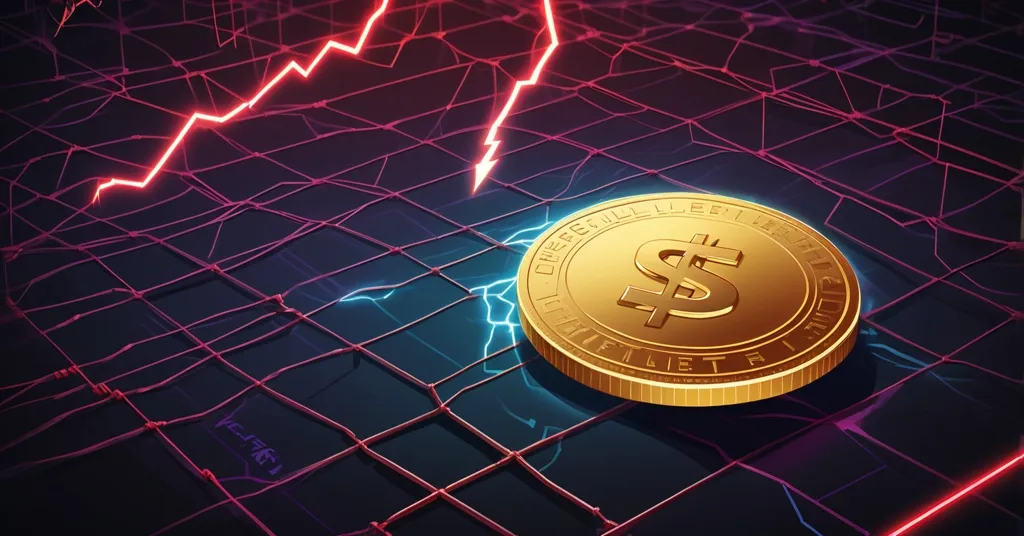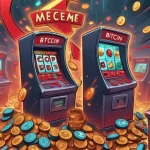Layer Brett Presale: Ethereum Layer 2 Meme Coin Hype or High-Risk Trap?

Layer Brett Presale Review: Next Dogecoin or Ethereum Layer 2 Meme Coin Trap?
A new meme coin, Layer Brett ($LBRETT), is generating serious buzz with its presale, promising to be the Dogecoin of 2025 thanks to Ethereum Layer 2 technology, dirt-cheap fees, and staking rewards that sound straight out of a fantasy novel. But is this a genuine opportunity to get in early on a game-changer, or just another speculative trap ready to fleece eager investors? Let’s slice through the hype and skepticism to see what’s really under the hood.
- Presale Snapshot: Tokens priced at $0.0047 (or $0.0044 in some reports) with staking rewards hyped at over 2,500% APY, even hitting 55,000% for early birds.
- Tech Claim: Built on Ethereum Layer 2 for meme coins, offering low gas fees and fast transactions, outpacing legacy meme coins like Dogecoin or Shiba Inu.
- Warning Signs: Sky-high APY numbers, lack of named expert backing, and vague utility plans scream caution.
The Tech Behind Layer Brett: A Real Edge?
Layer Brett is hitching its wagon to Ethereum Layer 2 technology, a solution designed to tackle the main network’s notorious issues—think gas fees that can hit $50 during peak times and transactions slower than a sloth on sedatives. Layer 2 works like a fast-track checkout line at a packed grocery store: it batches thousands of transactions off the main Ethereum chain, processes them cheaply and quickly, then settles the final result back on the blockchain. For Layer Brett, this translates to gas fees reportedly as low as pennies and near-instant confirmations, a stark contrast to older meme coins like Dogecoin or Shiba Inu, which often choke on congested networks or outdated tech.
This scalability isn’t just a gimmick; it’s a legit advantage if true. Ethereum’s ecosystem, despite its flaws, drives innovation in ways Bitcoin’s focus on sound money doesn’t, and Layer 2 solutions like Optimism or Arbitrum have proven their worth in DeFi and NFT projects. However, there’s a catch—promotional materials don’t specify which Layer 2 protocol Layer Brett uses, and that ambiguity is a minor red flag. Is it leveraging a battle-tested rollout, or something unproven? Without clarity, this technical edge of Layer 2 remains a half-baked selling point. Still, if it delivers, it could make $LBRETT more usable than competitors stuck paying through the nose for every transaction.
Presale Breakdown: Bargain or Bait?
Right now, Layer Brett tokens are up for grabs at $0.0047 each during the presale, though some sources peg it at $0.0044, hinting at possible pricing tiers or sloppy info from the project. You can buy in using ETH, USDT, or BNB through wallets like MetaMask or Trust Wallet, a standard setup for crypto presales. The real hook? Staking rewards with an Annual Percentage Yield (APY)—that’s the estimated yearly return on staked tokens—advertised at over 2,500%, with early participants supposedly scoring up to 55,000%. They’re also tossing in gamified staking perks, NFT integrations, a $1 million giveaway, and community campaigns to sweeten the deal.
Let’s be real: a 55,000% return isn’t just eye-popping; it’s the kind of number that should make you double-check if you’re on a phishing site. Imagine putting in $100 and seeing it balloon to $55,000 in a year—sounds like a jackpot, but if the project implodes, you’re left holding a bag of nothing. The pricing discrepancy also raises eyebrows; is this a sign of disorganized communication or unannounced presale rounds? Without a clear explanation from the team, it chips away at trust. Add a capped supply of 10 billion tokens under “transparent tokenomics” (the rules governing token supply and distribution), and it’s positioned as a controlled scarcity play—yet details on allocation or burn mechanisms are thin. For more on the presale, check out this expert take on Layer Brett’s potential.
Staking Rewards: Dream or Deception?
Those staking APY figures deserve a hard look. High yields in crypto often come from unsustainable models—think printing new tokens to pay rewards, which floods the market and tanks the value of each coin (a process called token inflation). Historical flops like Terra Luna’s UST, which promised 20% yields before crashing to zero in 2022, show how fast these setups can unravel. Layer Brett’s lack of audited mechanics or public economic models for sustaining 55,000% APY smells like either gross exaggeration or a ticking time bomb for late investors, as highlighted in recent warnings about high staking rewards.
Even if we give them the benefit of the doubt, such returns scream short-term hype to lure capital. Meme coin presales are notorious for this—promise the moon to early birds, then let the economics collapse once the buzz fades. If you’re tempted, ask yourself: where’s the proof this isn’t just a fancy lottery ticket with extra zeros? Without a whitepaper or transparent staking contract, it’s a gamble, not an investment.
Risks and Red Flags in Meme Coin Presales
Let’s not sugarcoat it: meme coin presales are a wild west of scams and broken promises. Rug pulls—where developers vanish with investor funds after a hyped launch—are all too common, with disasters like the 2021 Squid Game Token leaving players burned for millions. Layer Brett’s no-KYC approach aligns with decentralized freedom, a value we champion, but it also opens the door to fraud and money laundering, especially under the watchful eye of global regulators like the SEC cracking down on unregistered crypto offerings. A deeper look at these presale risks and rewards can shed light on the potential pitfalls.
Then there’s the “expert” hype. Promotional chatter claims “analysts” call Layer Brett the best crypto to buy now, with some predicting 300% gains post-listing, but not a single named source or credential backs this up. That’s not analysis; that’s marketing dressed up as insight. Utility promises like DeFi and NFT integrations sound slick, but where’s the roadmap? No partnerships, platforms, or timelines are public, leaving these as empty buzzwords for now. And while community engagement is touted, there’s little hard data on Discord activity or social media traction to prove real momentum beyond paid shills.
Market Context: Meme Coins in 2024-2025
Meme coins remain a polarizing force in crypto. They onboard normies who’d never touch Bitcoin, democratizing access through viral culture, but they’re also a cesspool of volatility and scams that smear the industry’s rep. Layer Brett’s tech edge over Shiba Inu or the original Brett on Base chain is notable, yet it pales next to established Layer 2 tokens like Polygon’s MATIC or Arbitrum’s ARB, which have developer ecosystems and real adoption. Is $LBRETT a serious contender, or just surfing a trendy wave? Some investment perspectives on meme coins might help weigh the decision.
The 2025 bull run narrative—tied to post-Bitcoin halving cycles—adds fuel to the speculation, but it’s far from a sure bet. Market cycles don’t run on a calendar, and banking on distant forecasts is a recipe for disappointment. Recent meme coins like Bonk saw explosive trading volume before fading; Pepe rode viral highs to painful lows. Without proven staying power, Layer Brett risks being another pump-and-dump footnote in a crowded field.
Bitcoin Maximalism vs. Altcoin Experimentation
As Bitcoin maximalists, we at Let’s Talk, Bitcoin see BTC as the bedrock of sound money—a decentralized store of value that no altcoin can match. Layer Brett’s speculative antics are a far cry from that mission, and frankly, they can distract from the core fight against centralized financial tyranny. Yet, we’re not blind to the reality: altcoins fill gaps Bitcoin doesn’t aim to. Meme coins like $LBRETT tap into cultural play and yield-chasing niches, while Ethereum’s ecosystem experiments with tech that could indirectly benefit the broader crypto revolution.
If Layer Brett proves itself, it’s the kind of bold gamble we need to shake up stagnant systems, embodying the effective accelerationism we root for—pushing tech forward, fast. But let’s not kid ourselves: Bitcoin remains the anchor. Projects like this are side bets, not the main event, and their failures shouldn’t derail the focus on true decentralization and privacy. For community insights, there’s ongoing discussion around Layer Brett staking rewards worth exploring.
Gamble or Game-Changer?
Layer Brett sits at a messy crossroads of innovation and speculation. On one hand, its Layer 2 foundation offers a tangible edge in a space desperate for usability, and its community-driven ethos aligns with the disruptive spirit we cheer. On the other, the ludicrous staking yields, vague utility plans, and history of meme coin scams paint a picture of high risk with questionable reward. Will $LBRETT redefine the meme coin playbook, or just clutter the crypto graveyard with another overhyped token?
If you’re itching to dive in, do your homework—dig for a whitepaper, vet the team (if they’re even public), and never bet more than you can lose. The crypto revolution thrives on experiments, but not every shiny lure hooks a winner. Stack your sats, keep a critical eye, and remember: disruption doesn’t mean desperation.
Key Takeaways and Questions on Layer Brett
- What is Layer Brett, and how does it differ from other meme coins?
Layer Brett is a new meme coin on Ethereum Layer 2, claiming an edge over Dogecoin or Shiba Inu with low gas fees and fast transactions via off-chain processing. - Are the staking rewards as lucrative as promised?
Advertised at over 2,500% APY, with early rates up to 55,000%, these figures lack audited proof and seem unsustainable, likely tied to risky token inflation. - Is Layer Brett a safe investment during its presale?
No meme coin presale is safe—unregulated, lacking expert validation, and with a history of scams, the $0.0047 entry price doesn’t offset the massive risks. - Could Layer Brett be the next Dogecoin by 2025?
Unlikely; Dogecoin’s rise was cultural, not tech-driven, and $LBRETT’s forced hype and unproven momentum make the comparison a stretch. - How does Layer 2 technology impact its potential?
Layer 2 cuts costs and speeds up transactions, making $LBRETT more practical than many rivals, but tech alone doesn’t ensure success in the meme coin gamble. - What should investors check before joining a meme coin presale?
Scrutinize the whitepaper, team transparency, community activity, and tokenomics for red flags; only risk what you’re prepared to lose. - Does Layer Brett align with the broader crypto revolution?
Partially—its decentralized ethos and tech innovation fit the fight for freedom, but speculative hype risks undermining the credibility of serious projects like Bitcoin.



